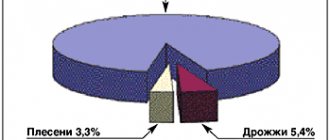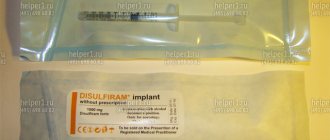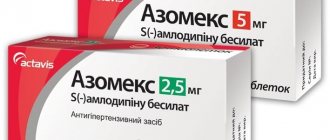Carbamazepine-Alsi Tablets, pack, 40 pcs., 200 mg, for oral administration
Pharmacotherapeutic group
An antiepileptic drug (dibenzazepine derivative), which also has a normothimic, antimanic, antidiuretic (in patients with diabetes insipidus) and analgesic (in patients with neuralgia) effect.
Inside, regardless of food intake, along with a small amount of liquid.
Epilepsy. Where possible, carbamazepine should be prescribed as monotherapy. Treatment begins with a small daily dose, which is subsequently slowly increased until the optimal effect is achieved.
The addition of carbamazepine to existing antiepileptic therapy should be carried out gradually, while the doses of the drugs used are not changed or, if necessary, adjusted.
For adults, the initial dose is 100-200 mg 1-2 times a day. Then the dose is slowly increased until the optimal therapeutic effect is achieved (usually 400 mg 2-3 times a day, maximum 1.6-2 g/day).
Children over 3 years old - at an initial dose of 20-60 mg/day, gradually increasing by 20-60 mg every other day.
In children over 3 years of age, the initial dose is 100 mg/day, the dose is increased gradually, every week by 100 mg. Maintenance doses: 10-20 mg/kg per day. (in several doses): for 4-5 years - 200-400 mg (in 1-2 doses), 6-10 years - 400-600 mg (in 2-3 doses), for 11-15 years - 600-1000 mg (in 2-3 doses).
For trigeminal neuralgia, 200-400 mg/day is prescribed on the first day, gradually increasing by no more than 200 mg/day. until pain stops (on average 400-800 mg/day), and then reduce to the minimum effective dose.
For pain syndrome of neurogenic origin, the initial dose is 100 mg 2 times a day. on the first day, then increase the dose by no more than 200 mg/day, if necessary increasing it by 100 mg every 12 hours until the pain subsides. Maintenance dose - 200-1200 mg/day. in several steps.
When treating elderly patients and patients with hypersensitivity, the initial dose is 100 mg 2 times a day.
Alcohol withdrawal syndrome: average dose - 200 mg 3 times a day; in severe cases, the dose can be increased to 400 mg 3 times a day during the first few days. At the beginning of treatment for severe withdrawal symptoms, it is recommended to prescribe in combination with sedative-hypnotic drugs (clomethiazole, chlordiazepoxide).
Diabetes insipidus: the average dose for adults is 200 mg 2-3 times a day. In children, the dose should be reduced according to the age and body weight of the child.
Diabetic neuropathy accompanied by pain: average dose - 200 mg 2-4 times a day. For the prevention of relapses of affective and schizoaffective psychoses - 600 mg/day. in 3-4 doses.
For acute manic states and affective (bipolar) disorders, daily doses are 400-1600 mg. The average daily dose is 400-600 mg (in 2-3 doses). In acute manic states, the dose is increased quickly; for maintenance treatment of affective disorders, the dose is increased gradually (to improve tolerability).
The mechanism of action is associated with the blockade of voltage-gated Na+ channels, which leads to stabilization of the neuronal membrane, inhibition of the occurrence of serial neuronal discharges and a decrease in synaptic conduction of impulses. Prevents the repeated formation of Na+-dependent action potentials in depolarized neurons. Reduces the release of the excitatory neurotransmitter amino acid glutamate, increases the reduced seizure threshold, etc. reduces the risk of developing an epileptic attack. Increases conductivity for K+, modulates voltage-gated Ca2+ channels, which can also determine the anticonvulsant effect of the drug. Corrects epileptic personality changes and, ultimately, increases the sociability of patients and promotes their social rehabilitation. It can be prescribed as the main therapeutic drug and in combination with other anticonvulsants. Effective for focal (partial) epileptic seizures (simple and complex), accompanied or not accompanied by secondary generalization, for generalized tonic-clonic epileptic seizures, as well as a combination of these types (usually ineffective for small seizures - petit mal, absence seizures and myoclonic seizures) .
In patients with epilepsy (especially children and adolescents), a positive effect on symptoms of anxiety and depression, as well as a decrease in irritability and aggressiveness, was noted. The effect on cognitive function and psychomotor performance is dose dependent and highly variable.
The onset of the anticonvulsant effect varies from several hours to several days (sometimes up to 1 month due to autoinduction of metabolism). In case of essential and secondary neuralgia of the trigeminal nerve, in most cases it prevents the occurrence of painful attacks. Effective for relieving neurogenic pain from tabes spinal cord, post-traumatic paresthesia and postherpetic neuralgia. Relief of pain in trigeminal neuralgia is observed after 8-72 hours. In alcohol withdrawal syndrome, it increases the threshold of convulsive readiness (which is usually reduced in this condition) and reduces the severity of the clinical manifestations of the syndrome (increased excitability, tremor, gait disturbances).
In patients with diabetes insipidus, it leads to rapid compensation of water balance, reduces diuresis and the feeling of thirst.
The antipsychotic (antimanic) effect develops after 7-10 days and may be due to inhibition of the metabolism of dopamine and norepinephrine.
Carbamazepine
When assessing the frequency of occurrence of various adverse reactions, the following gradations were used: very often - 10% and more often; often - 1-10%; sometimes - 0.1-1%; rarely - 0.01-0.1%; very rare - less than 0.01%.
Dose-related adverse reactions usually resolve within a few days, either spontaneously or after a temporary dose reduction. The development of adverse reactions from the central nervous system may be a consequence of a relative overdose of the drug or significant fluctuations in the concentrations of the active substance in plasma. In such cases, it is recommended to monitor the concentration of drugs in plasma.
From the side of the central nervous system: very often - dizziness, ataxia, drowsiness, asthenia; often - headache, accommodation paresis; sometimes - abnormal involuntary movements (for example, tremor, “fluttering” tremor - asterixis, dystonia, tics); nystagmus; rarely - orofacial dyskinesia, oculomotor disorders, speech disorders (eg dysarthria), choreoathetoid disorders, peripheral neuritis, paresthesia, myasthenia gravis and symptoms of paresis. The role of carbamazepine as a drug that causes or contributes to the development of neuroleptic malignant syndrome, especially when it is prescribed together with antipsychotics, remains unclear.
From the mental sphere: rarely - hallucinations (visual or auditory), depression, loss of appetite, anxiety, aggressive behavior, agitation, disorientation; very rarely - activation of psychosis.
Allergic reactions: often - urticaria; sometimes - erythroderma; rarely - lupus-like syndrome, skin itching; very rarely - exudative erythema multiforme (including Stevens-Johnson syndrome), toxic epidermal necrolysis (Lyell's syndrome), photosensitivity.
Rarely - multiorgan delayed-type hypersensitivity reactions with fever, skin rash, vasculitis (including erythema nodosum as a manifestation of cutaneous vasculitis), lymphadenopathy, signs resembling lymphoma, arthralgia, leukopenia, eosinophilia, hepatosplenomegaly and altered liver function tests (these manifestations found in various combinations). Other organs (eg, lungs, kidneys, pancreas, myocardium, colon) may also be involved. Very rarely - aseptic meningitis with myoclonus and peripheral eosinophilia, anaphylactoid reaction, angioedema, allergic pneumonitis or eosinophilic pneumonia. If the above allergic reactions occur, use of the drug should be discontinued.
From the hematopoietic organs: very often - leukopenia; often - thrombocytopenia, eosinophilia; rarely - leukocytosis, lymphadenopathy, folic acid deficiency; very rarely - agranulocytosis, aplastic anemia, true erythrocyte aplasia, megaloblastic anemia, acute intermittent porphyria, reticulocytosis, hemolytic anemia.
From the digestive system: very often - nausea, vomiting; often - dry mouth; sometimes - diarrhea or constipation, abdominal pain; very rarely - glossitis, stomatitis, pancreatitis.
From the liver: very often - increased GGT activity (due to the induction of this enzyme in the liver), which usually does not matter; often - increased alkaline phosphatase activity; sometimes - increased activity of “liver” transaminases; rarely - hepatitis of cholestatic, parenchymal (hepatocellular) or mixed type, jaundice; very rarely - granulomatous hepatitis, liver failure.
From the cardiovascular system: rarely - intracardiac conduction disorders; decrease or increase in blood pressure; very rarely - bradycardia, arrhythmias, AV block with fainting, collapse, worsening or development of CHF, exacerbation of coronary heart disease (including the appearance or increase in angina attacks), thrombophlebitis, thromboembolic syndrome.
From the endocrine system and metabolism: often - edema, fluid retention, weight gain, hyponatremia (decrease in plasma osmolarity due to an effect similar to the effect of ADH, which in rare cases leads to dilution hyponatremia, accompanied by lethargy, vomiting, headache, disorientation and neurological disorders); very rarely - hyperprolactinemia (may be accompanied by galactorrhea and gynecomastia); a decrease in the concentration of L-thyroxine (free T4, T4, T3) and an increase in the concentration of TSH (usually not accompanied by clinical manifestations); disorders of calcium-phosphorus metabolism in bone tissue (decreased concentrations of Ca2+ and 25-OH-colecalciferol in plasma): osteomalacia; hypercholesterolemia (including HDL cholesterol) and hypertriglyceridemia.
From the genitourinary system: very rarely - interstitial nephritis, renal failure, impaired renal function (for example, albuminuria, hematuria, oliguria, increased urea/azotemia), frequent urination, urinary retention, decreased potency.
From the musculoskeletal system: very rarely - arthralgia, myalgia or convulsions.
From the senses: very rarely - disturbances in taste, clouding of the lens, conjunctivitis; hearing impairment, incl. tinnitus, hyperacusis, hypoacusia, changes in the perception of pitch.
Other: skin pigmentation disorders, purpura, acne, increased sweating, alopecia. Rare cases of hirsutism have been reported, but the causal relationship of this complication with carbamazepine remains unclear. Overdose. Symptoms: usually reflect disorders of the central nervous system, cardiovascular system and respiratory system.
From the side of the central nervous system and sensory organs - depression of central nervous system functions, disorientation, drowsiness, agitation, hallucinations, fainting, coma; visual disturbances (“fog” before the eyes), dysarthria, nystagmus, ataxia, dyskinesia, hyperreflexia (initially), hyporeflexia (later); convulsions, psychomotor disorders, myoclonus, hypothermia, mydriasis).
From the cardiovascular system: tachycardia, decreased blood pressure, sometimes increased blood pressure, intraventricular conduction disturbances with widening of the QRS complex; heart failure.
From the respiratory system: respiratory depression, pulmonary edema.
From the digestive system: nausea and vomiting, delayed evacuation of food from the stomach, decreased motility of the colon.
From the urinary system: urinary retention, oliguria or anuria; fluid retention; dilution hyponatremia.
Laboratory indicators: leukocytosis or leukopenia, hyponatremia, metabolic acidosis, hyperglycemia and glycosuria, increased CPK muscle fraction.
Treatment: there is no specific antidote. Treatment is based on the patient's clinical condition; hospitalization, determination of the concentration of carbamazepine in plasma (to confirm poisoning with this drug and assess the degree of overdose), gastric lavage, administration of activated charcoal are indicated (late evacuation of gastric contents can lead to delayed absorption for 2 and 3 days and the reappearance of symptoms of intoxication during the recovery period) .
Forced diuresis, hemodialysis and peritoneal dialysis are ineffective (dialysis is indicated for a combination of severe poisoning and renal failure). Young children may require exchange transfusions. Symptomatic supportive treatment in the intensive care unit, monitoring of cardiac function, body temperature, corneal reflexes, renal and bladder function, correction of electrolyte disorders. When blood pressure decreases: position with the head end down, plasma expanders, if ineffective - intravenous dopamine or dobutamine; for heart rhythm disturbances, treatment is selected individually; for convulsions - administration of benzodiazepines (for example diazepam), with caution (due to a possible increase in respiratory depression) administration of other anticonvulsants (for example phenobarbital). With the development of dilution hyponatremia (water intoxication), limit the administration of fluids and slow intravenous infusion of a 0.9% NaCl solution (can help prevent the development of cerebral edema). It is recommended to carry out hemosorption on carbon sorbents.


